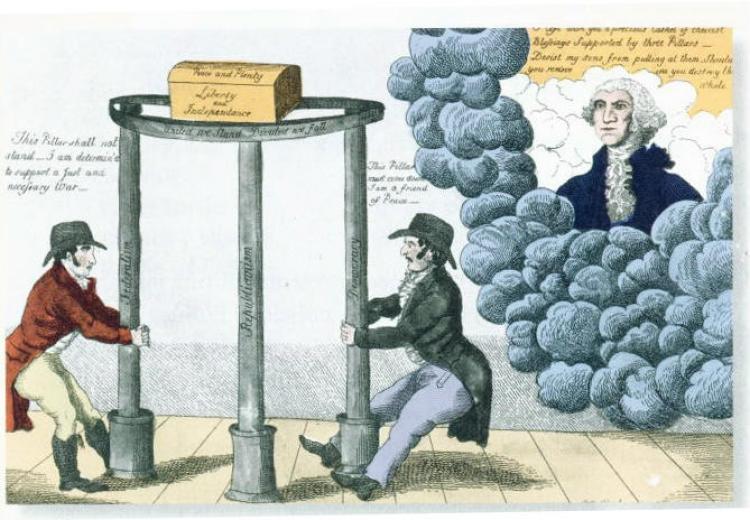The First American Party System: Events, Issues, and Positions

Cartoon depicting Former President Washington telling partisans to protect the pillars of Federalism, Republicanism and Democracy, ca. 1800.
"Jefferson's revolutionary viewpoints soon shaped the beginnings of a profound split in American politics. On one side, centering on the figure of the secretary of the treasury, Alexander Hamilton, were those favoring an energetic federal government, a strong presidency, and ties to England. On the other side, centered on Thomas Jefferson, were those favoring a less dynamic national government, a limited presidency, and ties to revolutionary France."
—From His Empire of Liberty
Fear of factionalism and political parties was deeply rooted in Anglo-American political culture before the American Revolution. Leaders such as George Washington and Thomas Jefferson hoped their new government, founded on the Constitution, would be motivated instead by a common intent, a unity. Though dominant, these sentiments were not held by all Americans. A delegate to the Massachusetts ratifying convention, for example, asserted that “competition of interest…between those persons who are in and those who are out office, will ever form one important check to the abuse of power in our representatives.” (Quoted in Hofstader, p. 36) Hamilton argued from a slightly different perspective in Federalist #70: “In the legislature, promptitude of decision is oftener an evil than a benefit. The differences of opinion, and the jarrings of parties in that department of the government, though they may sometimes obstruct salutary plans, yet often promote deliberation and circumspection, and serve to check excesses in the majority.”
In this unit, students will read the philosophical and policy statements of Hamilton, Jefferson, Madison, and others to better understand the nature and positions of the first political parties in the United States.
Guiding Questions
What are the essential elements of an organized political party?
What differences in philosophy led to the development of the Federalist and Democratic-Republican parties?
To what extent are political parties needed for the advancement of democracy?
What issues regarding political parties at the founding of the U.S. remain relevant to our democracy today?
Learning Objectives
Evaluate the factors that led to the development of the Federalists and Democratic-Republicans.
Analyze the motives behind the positions forwarded by the Federalists and Democratic-Republicans.
Evaluate the short and long term consequences of the establishment of political parties in the United States.
